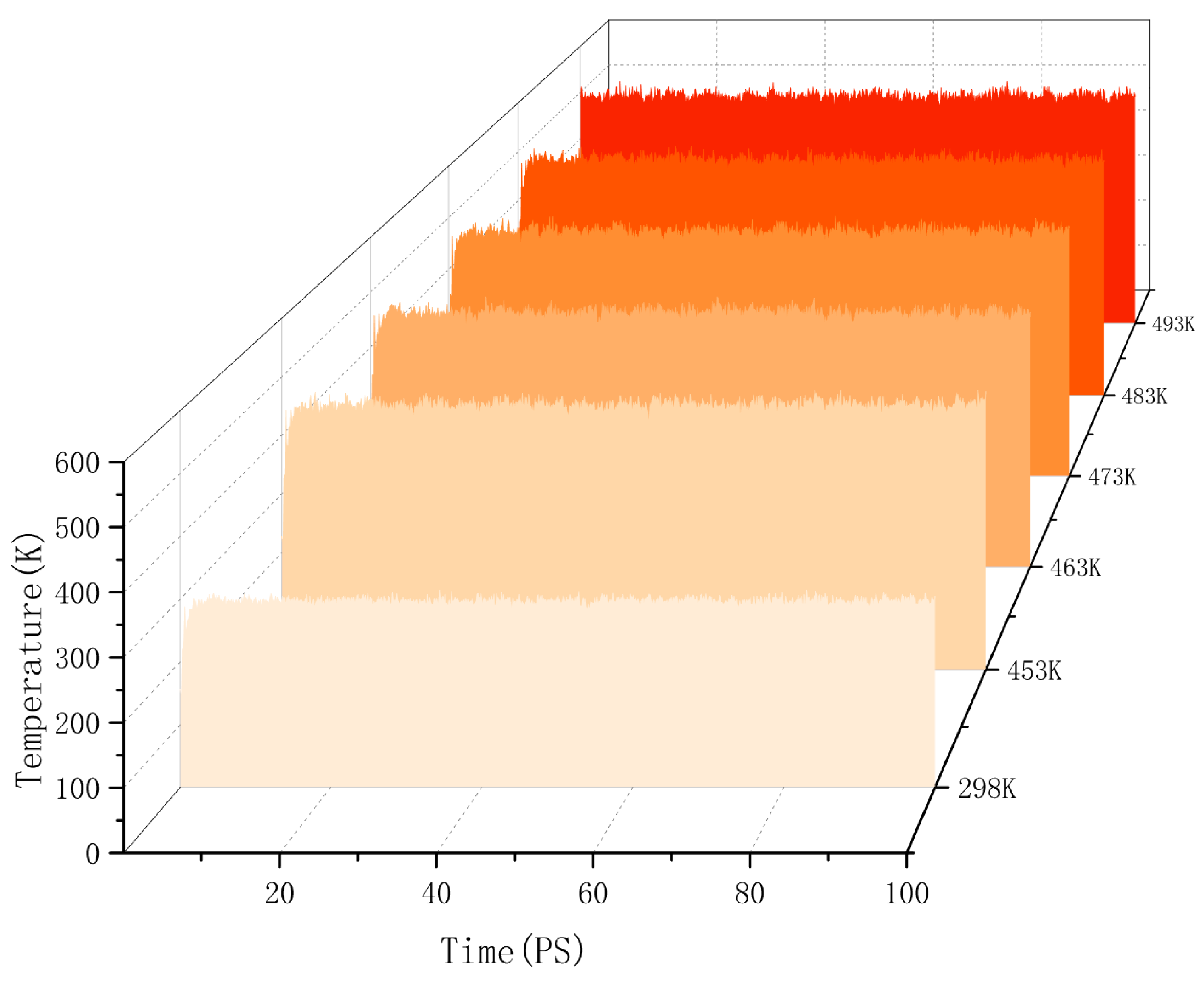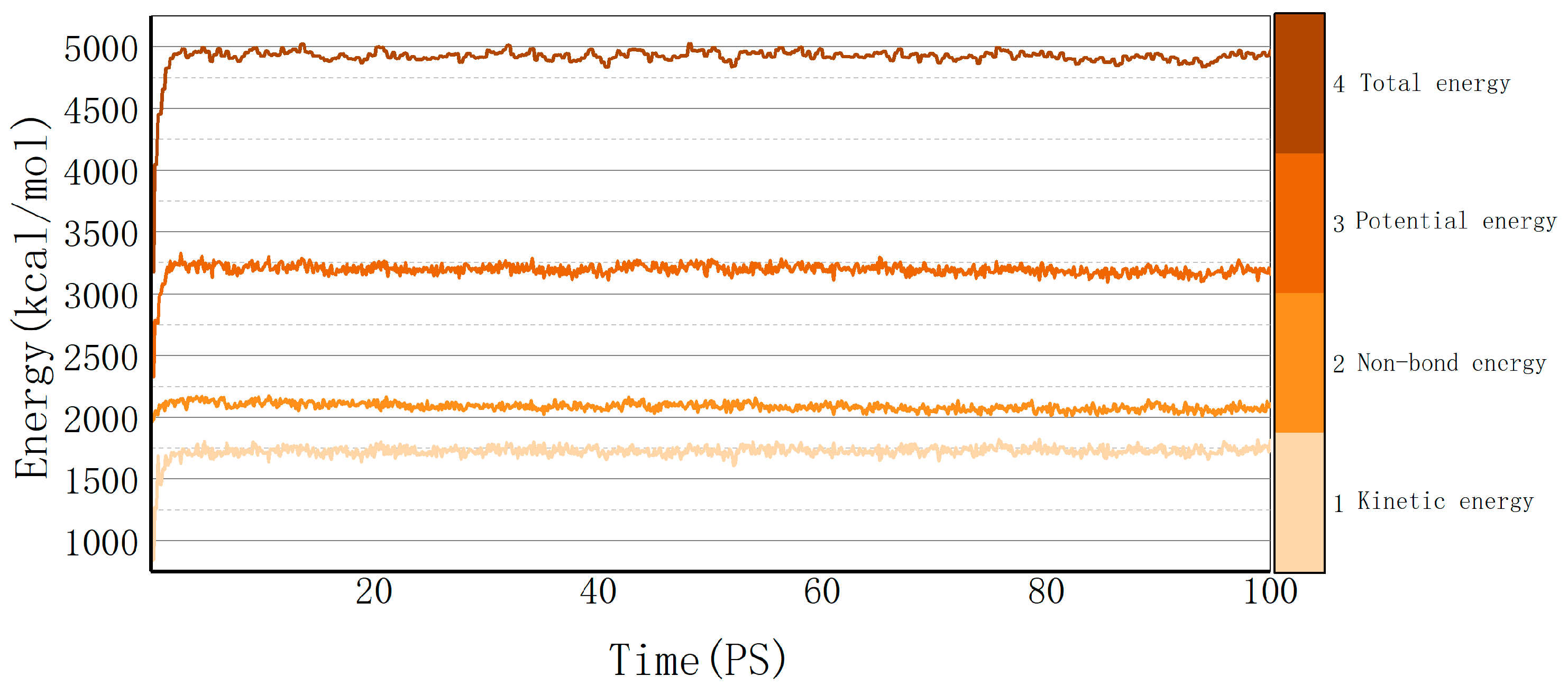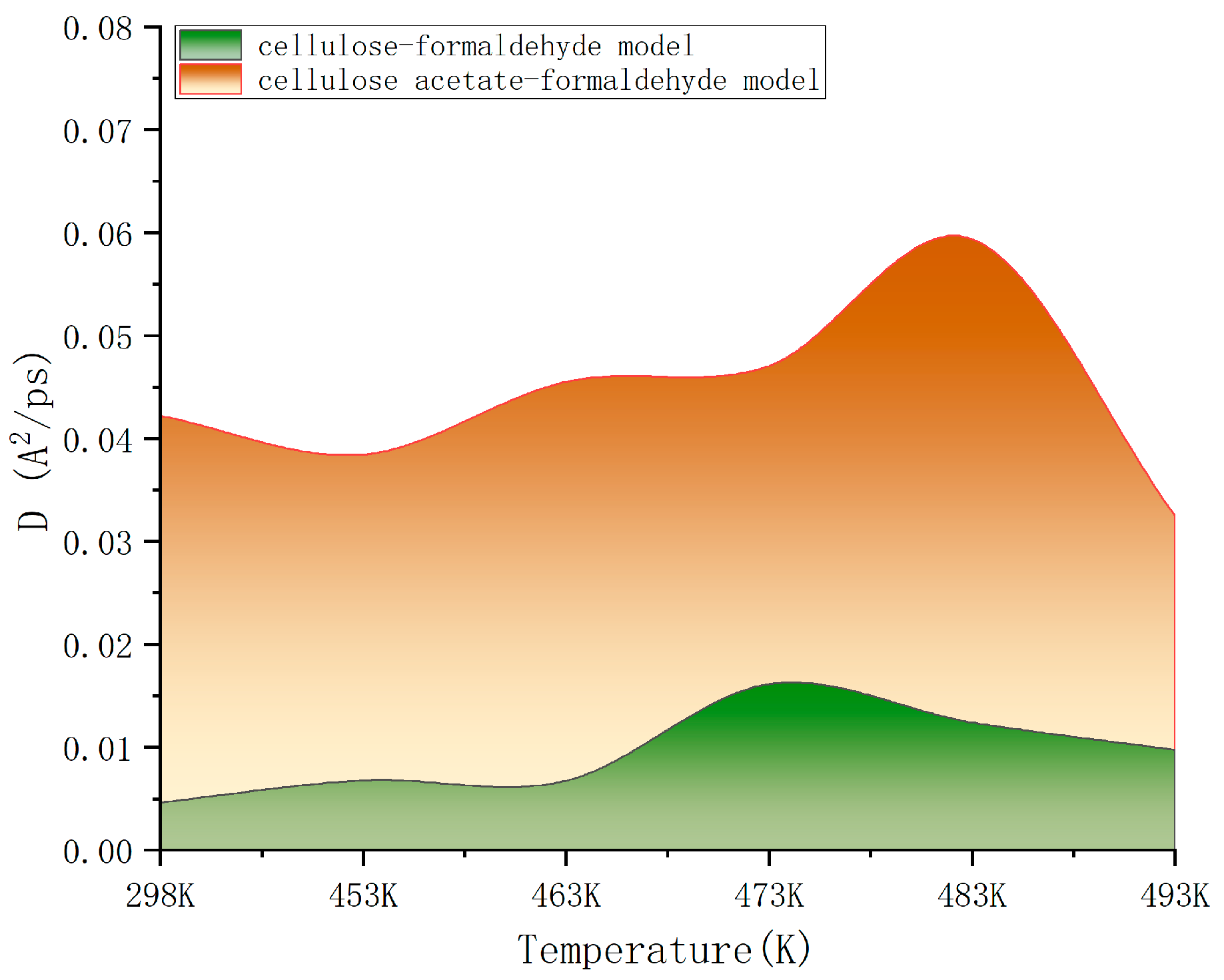The Effect of Heat Treatment and Acetylation on Formaldehyde Emission in Cellulose: A Molecular Dynamics Simulation Study
Abstract
1. Introduction
2. Experimental
2.1. Model Construction Parameter Setting
2.2. Parameter Setting
3. Results
3.1. System Equilibrium
3.2. Mean Square Displacement Calculation
3.3. Interaction Energy
3.4. Mechanical Performance Analysis
4. Discussion
5. Conclusions
- (1)
- With the increase in temperature, the diffusion coefficient of formaldehyde molecules in the model increased continuously but reached a peak of around 483 K and 493 K. On the one hand, it showed that the temperature helped to increase the diffusion movement of molecules, and on the other hand, it indicated that the acetylation led to the change of physical properties of cellulose, which created a better environment for the release of formaldehyde in wood;
- (2)
- The interaction energy of formaldehyde with both cellulose and cellulose–acetate was calculated to be negative, which represents the existence of their binding interaction, and the interaction energy of cellulose–acetate–formaldehyde model was lower than that of the cellulose–formaldehyde model, which represents that the binding interaction between formaldehyde and cellulose–acetate is weaker in the cellulose–formaldehyde model and formaldehyde molecules are more easily diffused rather than attracted by cellulose–acetate after acetylation, which proves that the acetylation modification of wood can better promote the release of formaldehyde;
- (3)
- The mechanical property data of the cellulose-amorphous zone produced irregular fluctuations in response to changes in temperature, and the decreases in the modulus of elasticity and Poisson’s ratio indicate that the temperature reduced the stiffness of the wood but increased the ductility of the wood. At the same time, the mechanical property values of the cellulose acetate–formaldehyde model were substantially lower than those of the normal cellulose model, indicating that the wood after acetylation was higher in ductility than the wood after heat treatment only, which may be an important hint for some processors who need high ductility properties of wood. Additionally, the study provides wood companies with an idea of how to detect formaldehyde emissions when pretreating wood. Wood modification methods exist in a variety of ways, and some novel wood modification methods may not be applicable to old formaldehyde detection methods in the future, while software simulations demonstrate a low-cost method for estimating formaldehyde emissions from wood.
Author Contributions
Funding
Institutional Review Board Statement
Informed Consent Statement
Data Availability Statement
Conflicts of Interest
References
- Kang, D.S.; Kim, H.S.; Jung, J.-H.; Lee, C.M.; Ahn, Y.-S.; Seo, Y.R. Formaldehyde exposure and leukemia risk: A comprehensive review and network-based toxicogenomic approach. Genes Environ. 2021, 43, 13. [Google Scholar] [CrossRef] [PubMed]
- Salem, M.Z.M.; Bohm, M. Understanding of Formaldehyde Emissions from Solid Wood: An Overview. BioResources 2013, 8, 4775–4790. [Google Scholar] [CrossRef]
- Meyer, B.; Boehme, C. Formaldehyde emission from solid wood. For. Prod. J. 1997, 47, 45–48. [Google Scholar]
- Schäfer, M.; Roffael, E. On the formaldehyde release of wood. Holz als Roh- und Werkst. 2000, 58, 259–264. [Google Scholar] [CrossRef]
- Zhang, J.; Song, F.; Tao, J.; Zhang, Z.; Shi, S.Q. Research Progress on Formaldehyde Emission of Wood-Based Panel. Int. J. Polym. Sci. 2018, 2018, 9349721. [Google Scholar] [CrossRef]
- Petinarakis, J.; Kavvouras, P. Technological factors affecting the emission of formaldehyde from particleboards. Wood Res. 2006, 51, 31–40. [Google Scholar]
- Rowell, R.M.; Dickerson, J.P. Acetylation of Wood. In Deterioration and Protection of Sustainable Biomaterials; ACS Symposium Series; American Chemical Society: Washington, DC, USA, 2014; Volume 1158, pp. 301–327. [Google Scholar]
- Mantanis, G. Chemical Modification of Wood by Acetylation or Furfurylation: A Review of the Present Scaled-up Technologies. BioResources 2017, 12, 4478–4489. [Google Scholar] [CrossRef]
- Cao, S.; Cheng, S.; Cai, J.B. Research Progress and Prospects of Wood High-temperature Heat Treatment Technology. BioResources 2022, 17, 3702–3717. [Google Scholar] [CrossRef]
- Li, W.; Ren, D.; Zhang, X.; Wang, H.; Yu, Y. The Furfurylation of Wood: A Nanomechanical Study of Modified Wood Cells. BioResources 2016, 11, 3614–3625. [Google Scholar] [CrossRef]
- Zhu, H.; Lu, Z.; Li, X.; Zhang, J.; Yuan, M. Analysis on test methods for determining formaldehyde emission from wood-based products. China Wood Ind. 2009, 2009, 37–40. [Google Scholar]
- Zhang, J.; Shaw, C.; Kanabus-Kaminska, J.; MacDonald, R.; Magee, R.; Lusztyk, E.; Weichert, H. Study of Air Velocity and Turbulence Effects on Organic Compounds Emissions from Building Materials/Furnishings Using a New Small Test Chamber; American Society for Testing and Materials: West Conshohocken, PA, USA, 1996. [Google Scholar]
- Carvalho, L.; Magalhães, F.; Ferra, J. Formaldehyde emissions from wood-based panels-Testing methods and industrial perspectives. In Formaldehyde: Chemistry, Applications and Role in Polymerization; Nova Science Publishers, Inc.: Hauppauge, NY, USA, 2012; pp. 1–45. [Google Scholar]
- Shao, J.; Chen, Y.; Dong, L.; Yuan, T.; Zhang, Z.; Zhang, J. Correlation between the Desiccator Method and 1 m3 Climate Chamber Method for Measuring Formaldehyde Emissions from Veneered Particleboard. Processes 2022, 10, 1023. [Google Scholar] [CrossRef]
- Baldelli, A.; Jeronimo, M.; Tinney, M.; Bartlett, K.H. Real-time measurements of formaldehyde emissions in a gross anatomy laboratory. SN Appl. Sci. 2020, 2, 769. [Google Scholar] [CrossRef]
- Kamperidou, V. Chemical and Structural Characterization of Poplar and Black Pine Wood Exposed to Short Thermal Modification. Drvna Ind. 2021, 72, 155–167. [Google Scholar] [CrossRef]
- Wang, W.; Cao, Y.; Sun, L.; Wu, M. Effect of Temperature on Formaldehyde Diffusion in Cellulose Amorphous Region: A Simulation Study. BioResources 2021, 16, 3200–3213. [Google Scholar] [CrossRef]
- Onyon, P.F. Polymer Handbook. Nature 1972, 238, 56. [Google Scholar] [CrossRef]
- Mazeau, K.; Heux, L. Molecular Dynamics Simulations of Bulk Native Crystalline and Amorphous Structures of Cellulose. J. Phys. Chem. B 2003, 107, 2394–2403. [Google Scholar] [CrossRef]
- Esteves, B.; Pereira, H. Wood modification by heat treatment: A review. BioResources 2009, 4, 370–404. [Google Scholar] [CrossRef]
- Wang, W.; Wang, Y.; Li, X. Molecular Dynamics Study on Mechanical Properties of Cellulose with Air/Nitrogen Diffusion Behavior. BioResources 2018, 13, 7900–7910. [Google Scholar] [CrossRef]
- Liu, X.; Schnell, S.K.; Simon, J.-M.; Krüger, P.; Bedeaux, D.; Kjelstrup, S.; Bardow, A.; Vlugt, T.J.H. Diffusion Coefficients from Molecular Dynamics Simulations in Binary and Ternary Mixtures. Int. J. Thermophys. 2013, 34, 1169–1196. [Google Scholar] [CrossRef]
- Li, X.; Zhao, Y.; Wang, S.; Xie, X. Molecular dynamics simulation study of a polynorbornene-based polymer: A prediction of proton exchange membrane design and performance. Int. J. Hydrogen Energy 2016, 41, 16254–16263. [Google Scholar] [CrossRef]
- Einstein, A. Zur Elektrodynamik bewegter Körper. In Das Relativitätsprinzip: Eine Sammlung von Abhandlungen; Lorentz, H.A., Einstein, A., Minkowski, H., Eds.; Vieweg + Teubner Verlag: Wiesbaden, Germany, 1923; pp. 26–50. [Google Scholar]
- Hanuš, J.; Mazeau, K. The xyloglucan-cellulose assembly at the atomic scale. Biopolymers 2006, 82, 59–73. [Google Scholar] [CrossRef] [PubMed]
- Ouyang, D.; Zhang, L.; Mao, R.; Qin, X.; Pang, W. Application Process of Coating Agent and the Coating Effect Evaluation Based on Molecular Dynamics. Langmuir 2023, 39, 3411–3419. [Google Scholar] [CrossRef] [PubMed]
- Medeiros, D.T.d.; Batista, F.G.; Melo, R.R.d.; Mascarenhas, A.R.P.; Pedrosa, T.D. Alterações físico-mecânicas na madeira de cambará (Qualea paraensis) termorretificada. Madera y Bosques 2021, 27, e2722176. [Google Scholar] [CrossRef]
- Inoue, M.K.; Norimoto, M.; Tanahashi, M.; Rowell, R.M. Steam or Heat Fixation of Compressed Wood. Wood Fiber Sci. 2007, 25, 224–235. [Google Scholar]
- Esteves, B.; Marques, A.V.; Domingos, I.; Pereira, H. Influence of steam heating on the properties of pine (Pinus pinaster) and eucalypt (Eucalyptus globulus) wood. Wood Sci. Technol. 2007, 41, 193–207. [Google Scholar] [CrossRef]
- Mitchell, P.H. Irreversible property changes of small loblolly pine specimens heated in air, nitrogen, or oxygen. Wood Fiber Sci. 1988, 20, 320–335. [Google Scholar]
- Boonstra, M.J.; Tjeerdsma, B. Chemical analysis of heat treated softwoods. Holz als Roh- und Werkst. 2006, 64, 204–211. [Google Scholar] [CrossRef]






| Temperature (K) | Model (Kcal/mol) | Eab (Kcal/mol) | Ea (Kcal/mol) | Eb (Kcal/mol) | Einter (Kcal/mol) |
|---|---|---|---|---|---|
| 298 K | a | 787.0598 | 36.1044 | 967.7645 | −216.8092 |
| b | −101.4967 | 56.2139 | 17.8178 | −175.5284 | |
| 453 K | a | 1029.2168 | 62.3439 | 1150.0686 | −183.1956 |
| b | 233.6271 | 79.5291 | 323.1206 | −169.0225 | |
| 463 K | a | 971.1494 | 57.2065 | 1088.2146 | −174.2716 |
| b | 234.4420 | 78.1113 | 312.1924 | −155.8617 | |
| 473 K | a | 1026.9366 | 45.2065 | 1161.0271 | −179.2969 |
| b | 327.7988 | 73.3346 | 404.8575 | −150.3933 | |
| 483 K | a | 1111.4648 | 56.3503 | 1224.6424 | −169.5279 |
| b | 356.5479 | 75.3426 | 431.9402 | −150.7349 | |
| 493 K | a | 1086.3209 | 70.2814 | 1189.2733 | −173.2338 |
| b | 332.3600 | 66.0030 | 419.6570 | −153.3000 |
| Pressure (MPa) | Model | λ | μ | K | G | E | K/G | |
|---|---|---|---|---|---|---|---|---|
| 298 K | a | 13.84 | 9.25 | 13.92 | 9.25 | 24.06 | 0.30 | 1.50 |
| b | 3.71 | 1.73 | 4.10 | 1.73 | 4.64 | 0.34 | 2.37 | |
| 453 K | a | 14.30 | 5.58 | 14.42 | 5.58 | 15.17 | 0.36 | 2.58 |
| b | 4.74 | 2.44 | 5.01 | 2.44 | 6.48 | 0.33 | 2.06 | |
| 463 K | a | 12.55 | 5.80 | 12.67 | 5.80 | 15.57 | 0.34 | 2.18 |
| b | 4.45 | 1.47 | 4.90 | 1.47 | 4.05 | 0.38 | 3.33 | |
| 473 K | a | 16.67 | 5.55 | 16.79 | 5.55 | 15.25 | 0.38 | 3.03 |
| b | 3.87 | 1.54 | 4.30 | 1.54 | 4.18 | 0.36 | 2.79 | |
| 483 K | a | 18.19 | 5.12 | 18.32 | 5.12 | 14.25 | 0.39 | 3.58 |
| b | 4.62 | 2.80 | 4.86 | 2.80 | 7.34 | 0.31 | 1.74 | |
| 493 K | a | 12.11 | 4.86 | 12.24 | 4.86 | 13.20 | 0.36 | 2.52 |
| b | 5.54 | 1.64 | 5.95 | 1.64 | 4.55 | 0.39 | 3.63 |
Disclaimer/Publisher’s Note: The statements, opinions and data contained in all publications are solely those of the individual author(s) and contributor(s) and not of MDPI and/or the editor(s). MDPI and/or the editor(s) disclaim responsibility for any injury to people or property resulting from any ideas, methods, instructions or products referred to in the content. |
© 2023 by the authors. Licensee MDPI, Basel, Switzerland. This article is an open access article distributed under the terms and conditions of the Creative Commons Attribution (CC BY) license (https://creativecommons.org/licenses/by/4.0/).
Share and Cite
Li, N.; Hua, Y.; Wang, J.; Li, J.; Wang, W. The Effect of Heat Treatment and Acetylation on Formaldehyde Emission in Cellulose: A Molecular Dynamics Simulation Study. Forests 2023, 14, 839. https://doi.org/10.3390/f14040839
Li N, Hua Y, Wang J, Li J, Wang W. The Effect of Heat Treatment and Acetylation on Formaldehyde Emission in Cellulose: A Molecular Dynamics Simulation Study. Forests. 2023; 14(4):839. https://doi.org/10.3390/f14040839
Chicago/Turabian StyleLi, Ning, Youna Hua, Jia Wang, Juncheng Li, and Wei Wang. 2023. "The Effect of Heat Treatment and Acetylation on Formaldehyde Emission in Cellulose: A Molecular Dynamics Simulation Study" Forests 14, no. 4: 839. https://doi.org/10.3390/f14040839
APA StyleLi, N., Hua, Y., Wang, J., Li, J., & Wang, W. (2023). The Effect of Heat Treatment and Acetylation on Formaldehyde Emission in Cellulose: A Molecular Dynamics Simulation Study. Forests, 14(4), 839. https://doi.org/10.3390/f14040839





